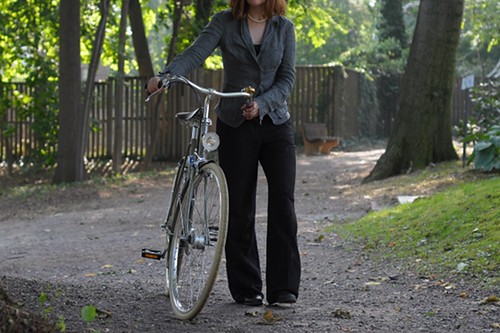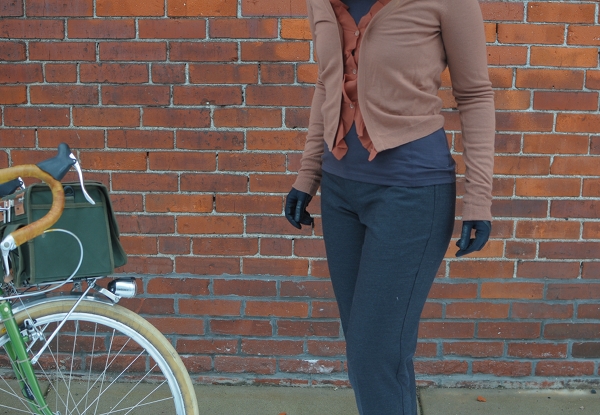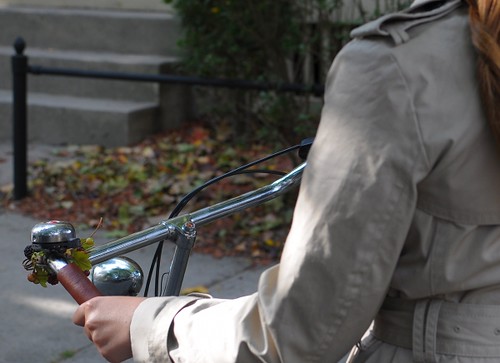One question I am often asked about cycling to work, is how to avoid wrinkles on business and formal attire. I don't have many pictures of myself dressed up, but I do cycle in suits and dresses that fall into the business/ formal category. And rather than avoid wrinkles, I tend to choose clothing that either doesn't wrinkle easily, or that is meant to look wrinkled. This habit is a hold-over from a life of constant travel combined with a hatred of dry-cleaning and ironing boards, and it lends itself well to cycling. Here are some suggestions I can make from personal experience.
My go-to fabric for looking presentable in the warmer months is linen (shown above). I own several linen skirt and pant suits, and I mix and match them to create a variety of outfits. People tend to think of linen as a limited, "afternoon tea at a resort" sort of fabric, but in fact it comes in many weights and textures. A dark, crisply tailored linen suit can look formal, while a pastel gauzy linen dress can look whimsical. But what all linens have in common is that they actually look good wrinkled; wrinkles are part of their "personality." That's what makes them great for tossing into a suitcase, and it's also what allows me to get on and off the bike as many times as I want without worrying whether my skirt needs to be frantically smoothed out before a meeting.
I am also a fan of "twist-dried" designs. There may be a formal name for this process that escapes me, so someone please help me out. But what I mean is that there is a style of shirts, skirts, even evening dresses where the wrinkles are part of the garment's very design. This is achieved by drying the article of clothing in a wrung-out, or twisted manner. The resulting wrinkles are clearly intentional. They add a sense of structure and the illusion of subtle colour variation to the fabric once it is dry. Typically, the twist-dried effect is produced by the manufacturer, but you can create it on your own by simply drying any shirt, skirt, or dress (crisp cottons and silks with no pockets work best) in this fashion. Having wrinkles as an inherent design element of your outfit eliminates the need to worry about them.
To some extent, the same idea can be generalised to textured fabrics. Tweed, seersucker, lace, embroidery - the texture both disguises wrinkles and somewhat prevents them from forming.
If your dress code limits you to more conventional suiting, I have found that wool skirts and trousers tend to be more forgiving as far as wrinkling goes than other fabrics. They still wrinkle, just less so. Not getting on and off the bicycle saddle every time I stop (but leaning the bike and putting a toe down instead) has been helpful in preventing wrinkles from forming as well.
Of course for dresses there is wool jersey, though it has become increasingly more difficult to find ready-made. I've been working with a designer to help create a cycling-specific dress with a couple of interesting features, and one reason we chose jersey is for its non-wrinkling properties. While I prefer wool or bamboo jersey, cotton jersey and various artificial blends work well in this respect also and are easier to find in stores. Ibex and Icebreaker have begun to make wool jersey dresses, and while theirs tend to lean toward the more casual, it's a promising sign. The nice thing about jersey fabrics, is that they not only resist wrinkling, but also have some give to them, allowing you to move easier on the bike.
One last suggestion I can make for those whose clothing is wrinkle-prone, is to try throwing a coat on over the outfit. Granted, this works best in cooler weather, with stiff wool coats. But in warmer weather even a thin trenchcoat can be helpful.
While cycling to work is easy if your typical wardrobe already lends itself to it, I think it's important to address the concerns of those who would like to ride in their regular clothing but, for whatever reason, find it impractical. Sometimes it is a matter of having the right bike or accessories, other times it's a matter of making minor alterations to your wardrobe without inherently changing the way you dress. What are yours strategies for dealing with wrinkles and other forms of dishevelment that cycling may impose on your clothing? If it were crucial in your line of work to always look crisp and impeccably groomed, would you still ride to work?









0 comments:
Post a Comment